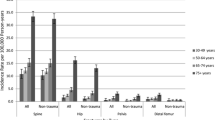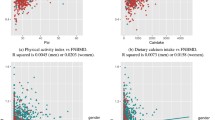Abstract
Only a few studies have examined the risk of individual chronic health disorders on perimenopausal (i.e., around menopause) fractures in a single study. We evaluated the effect of chronic illnesses on fracture rate in a prospective cohort study of 3,078 women. These women were a stratified sample from the population base of 14,220 women aged 47–56 years and residing in the province of Kuopio in eastern Finland in 1989. Data on physician-diagnosed chronic diseases were collected by a baseline questionnaire in 1989. For certain diseases, questionnaire information of self-reported chronic disorders were compared with drug reimbursement data provided by the Social Insurance Institution of Finland. Axial bone mineral density (BMD) measurements from the femoral neck and lumbar spine were performed in 1989–91. Two hundred sixty-five (265) women experienced at least one fracture during the follow-up period of 3.6 years (SD±0.78). The first fracture during the follow-up period was taken to be the end-point event. The risk of follow-up fracture for an individual health disorder was estimated with the Cox’s proportional hazards model. Several chronic health disorders increased the fracture risk in perimenopausal women. However, hypertension was a statistically significant ( p=0.018) risk factor for fracture (adjusted hazard ratio [HR], 1.4; 95% confidence interval [CI], 1.1–1.9), especially in overweight and obese (body mass index ≥28) women (HR, 2.0; 95% CI, 1.4–3.0). In addition, coronary heart disease (adjusted HR, 1.76; 95% CI, 1.13–2.76), hyperthyroidism (adjusted HR, 1.7; 95% CI, 1.0–2.9), epilepsy (adjusted HR, 2.0; 95% CI, 1.1–3.6), alcoholism (adjusted HR, 3.5; 95% CI, 1.3–9.5) and chronic hepatic disease (adjusted HR, 5.2; 95% CI, 1.7–16.4) predicted fracture. BMD was either normal or even elevated in disease groups. However, women with a fracture during the follow-up usually had decreased bone density, although the difference was statistically significant only in women with hypertension and hyperthyroidism. We conclude that hypertension, coronary heart disease, alcoholism, epilepsy and hyperthyroidism can markedly increase the risk of fracture in perimenopausal women and should be taken into account when assessing the risk of future fracture in an individual patient. Furthermore, in contrast to previous data, obesity alone does not increase the risk of perimenopausal fracture, but in association with hypertension the risk seems to be markedly elevated.

Similar content being viewed by others
References
Lips P (1997) Epidemiology and predictors of fractures associated with osteoporosis. Am J Med 103:3S–8S
Wu F, Mason B, Horne A, Ames R, Clearwater J, Liu M, Evans MC, Gamble GD, Reid IR (2002) Fractures between the ages of 20 and 50 years increase women’s risk of subsequent fractures. Arch Intern Med 162:33–36
Cauley JA, Robbins J, Chen Z, Cummings SR, Jackson RD, LaCroix AZ, LeBoff M, Lewis CE, McGowan J, Neuner J, Pettinger M, Stefanick ML, Wactawski-Wende J, Watts NB, Women’s Health Initiative Investigators (2003) Effects of estrogen plus progestin on risk of fracture and bone mineral density: the Women’s Health Initiative randomized trial. JAMA 290:1729–1738
Nordin BE (1997) Calcium and osteoporosis. Nutrition 13:664–686
Stein E, Shane E (2003) Secondary osteoporosis. Endocrinol Metab Clin North Am 32:115–134, vii
Luukinen H, Koski K, Laippala P, Kivela SL (1995) Predictors for recurrent falls among the home-dwelling elderly. Scand J Prim Health Care 13:294–299
Rubenstein LZ, Josephson KR (2002) The epidemiology of falls and syncope. Clin Geriatr Med 18:141–158
Ensrud KE, Nevitt MC, Yunis C, Cauley JA, Seeley DG, Fox KM, Cummings SR (1994) Correlates of impaired function in older women. Am Geriatr Soc 42:481–489
Torgerson DJ, Garton MJ, Reid DM (1993) Falling and perimenopausal women. Age Ageing 22:59–64
Randell KM, Honkanen RJ, Komulainen MH, Tuppurainen MT, Kroger H, Saarikoski S (2001) Hormone replacement therapy and risk of falling in early postmenopausal women—a population-based study. Clin Endocrinol (Oxf) 54:769–774
Huopio J, Kroger H, Honkanen R, Saarikoski S, Alhava E (2000) Risk factors for perimenopausal fractures: a prospective study. Osteoporos Int 11:219–227
Kroger H, Tuppurainen M, Honkanen R, Alhava E, Saarikoski S (1994) Bone mineral density and risk factors for osteoporosis—a population-based study of 1600 perimenopausal women. Calcif Tissue Int 55:1–7
Honkanen K, Honkanen R, Heikkinen L, Kroger H, Saarikoski S (1999) Validity of self-reports of fractures in perimenopausal women. Am J Epidemiol 1 150(5):511–516
Cummings SR, Nevitt MC, Browner WS, Stone K, Fox KM, Ensrud KE, Cauley J, Black D, Vogt TM (1995) Risk factors for hip fracture in white women. Study of Osteoporotic Fractures Research Group. N Engl J Med 332:767–773
Willig R, Luukinen H, Jalovaara P (2003) Factors related to occurrence of hip fracture during a fall on the hip. Public Health 117:25–30
Hasselman CT, Vogt MT, Stone KL, Cauley JA, Conti SF (2003) Foot and ankle fractures in elderly white women. Incidence and risk factors. J Bone Joint Surg Am 85:820–824
Nicodemus KK, Folsom AR; Iowa Women’s Health Study (2001) Type 1 and type 2 diabetes and incident hip fractures in postmenopausal women. Diabetes Care 24:1192–1197
Valtola A, Honkanen R, Kroger H, Tuppurainen M, Saarikoski S, Alhava E (2002) Lifestyle and other factors predict ankle fractures in perimenopausal women: a population-based prospective cohort study. Bone 30:238–242
Feskanich D, Willett WC, Stampfer MJ, Colditz GA (1997) A prospective study of thiazide use and fractures in women. Osteoporos Int 7(1):79–84
Melton LJ 3rd, Achenbach SJ, O’Fallon WM, Khosla S (2002) Secondary osteoporosis and the risk of distal forearm fractures in men and women. Bone 31:119–125
Bauer DC, Ettinger B, Nevitt MC, Stone KL; Study of Osteoporotic Fractures Research Group (2001) Risk for fracture in women with low serum levels of thyroid-stimulating hormone. Ann Intern Med 134:561–568
Solomon BL, Wartofsky L, Burman KD (1993) Prevalence of fractures in postmenopausal women with thyroid disease. Thyroid 3:17–23
Vestergaard P, Mosekilde L (2003) Hyperthyroidism, bone mineral, and fracture risk—a meta-analysis. Thyroid 13:585–593
Persson HB, Alberts KA, Farahmand BY, Tomson T (2002) Risk of extremity fractures in adult outpatients with epilepsy. Epilepsia 43:768–772
Vestergaard P, Rejnmark L, Mosekilde L (2004) Fracture risk associated with use of antiepileptic drugs. Epilepsia 45(11):1330–1337
Clark MK, Sowers MF, Dekordi F, Nichols S (2003) Bone mineral density and fractures among alcohol-dependent women in treatment and in recovery. Osteoporos Int 14:396–403
Colditz GA, Martin P, Stampfer MJ, Willett WC, Sampson L, Rosner B, Hennekens CH, Speizer FE (1986). Validation of questionnaire information on risk factors and disease outcomes in a prospective study of women. Am J Epidemiol 123:894–900
Klungel OH, de Boer A, Paes AH, Seidell JC, Bakker A (1999) Cardiovascular diseases and risk factors in a population-based study in the Netherlands: agreement between questionnaire information and medical records. Neth J Med 55:177–183
Haapanen N, Miilunpalo S, Pasanen M, Oja P, Vuori I (1997) Agreement between questionnaire data and medical records of chronic diseases in middle-aged and elderly Finnish men and women . Am J Epidemiol (15)145:762–769
Sowers MR, Clark MK, Jannausch ML, Wallace RB (1993) Body size, estrogen use and thiazide diuretic use affect 5-year radial bone loss in postmenopausal women. Osteoporos Int 3(6):314–321
Reid IR, Ames RW, Orr-Walker BJ, Clearwater JM, Horne AM, Evans MC, Murray MA, McNeil AR, Gamble GD (2000) Hydrochlorothiazide reduces loss of cortical bone in normal postmenopausal women: a randomized controlled trial. Am J Med 109(5):362–70
Le Couteur DG, Fisher AA, Davis MW, McLean AJ (2003) Postprandial systolic blood pressure responses of older people in residential care: Association with risk of falling. Gerontology 49:260–264
Author information
Authors and Affiliations
Corresponding author
Rights and permissions
About this article
Cite this article
Huopio, J., Honkanen, R., Jurvelin, J. et al. Role of chronic health disorders in perimenopausal fractures. Osteoporos Int 16, 1404–1411 (2005). https://doi.org/10.1007/s00198-005-1851-2
Received:
Accepted:
Published:
Issue Date:
DOI: https://doi.org/10.1007/s00198-005-1851-2




